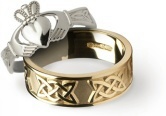Blog Categories
Blog CategoriesWho were the Claddagh community of Galway?
Who were the Claddagh community? The Claddagh ring is known worldwide and is one of the most instantly recognizable and best loved symbols of Ireland but the rural community that the name comes from has a much lesser known history.
 |
| Claddagh Village |
Galway is known as the Town of the Tribes and the name Claddagh which is just outside the city comes from the Irish "Cladach" or "the shore”. It was an old fishing village located in a picturesque spot just where the Corrib River meets Galway Bay. It’s the home of the man who is believed to have created the Claddagh ring symbol.
The old thatched cottages of Claddagh could be spotted until the 1930s when they were replaced with more modern dwellings but the traditions and customs of this Irish speaking village still live on to this day.
 |
| Traditional Silver Claddagh Ring Design |
So who were these people? The men worked as fishermen and the women mostly looked after the houses. It was said that there were up to 500 families living there but this started to decline when younger generations wanted to move into the city. The Claddagh fishermen were important as they were the sole men with the rights to fish in Galway Bay. This was very lucrative for them as they could bring their fish to sell in the markets of Galway. It was a thriving industry now long gone - it’s believed that in the early 19th century there were over 800 fishermen in the village who ran around 80 vessels.
 |
| Traditional Gold Claddagh Ring Design |
There’s a now iconic photograph of one of these members of the Claddagh community - Main Ní Tuathail - who at age 14 was one of the first people in Ireland to be photographed in color. Her striking photo in a burgundy cloak was taken by two French women Madeleine Mignon-Alba and Marguerite Mespoulet.
The fishermen worked in Galway ‘Hooker’ boats and they were led by an elected King. He was chosen every year on Saint John’s Day (June 23rd) with huge high-profile celebrations in the community. Traditions were strong and it was said that by the King’s orders any outsider (meaning a person not from the Claddagh village) found fishing in the Bay could have their nets and boats destroyed. The story goes that the people of Claddagh could be recognized immediately as they wore the ring on their fingers.
 |
| Birthstone Claddagh Ring |
Tragedy and disaster came to the Claddagh community in 1927 when a deadly outbreak of tuberculosis spread rapidly through the village and the order was given to raze all the homes to the ground and evacuate families. The last of the structures were destroyed in 1934 and this marked the end of the Claddagh community.
It could never have been predicted at the time that the fame of this village would reach across the world!
